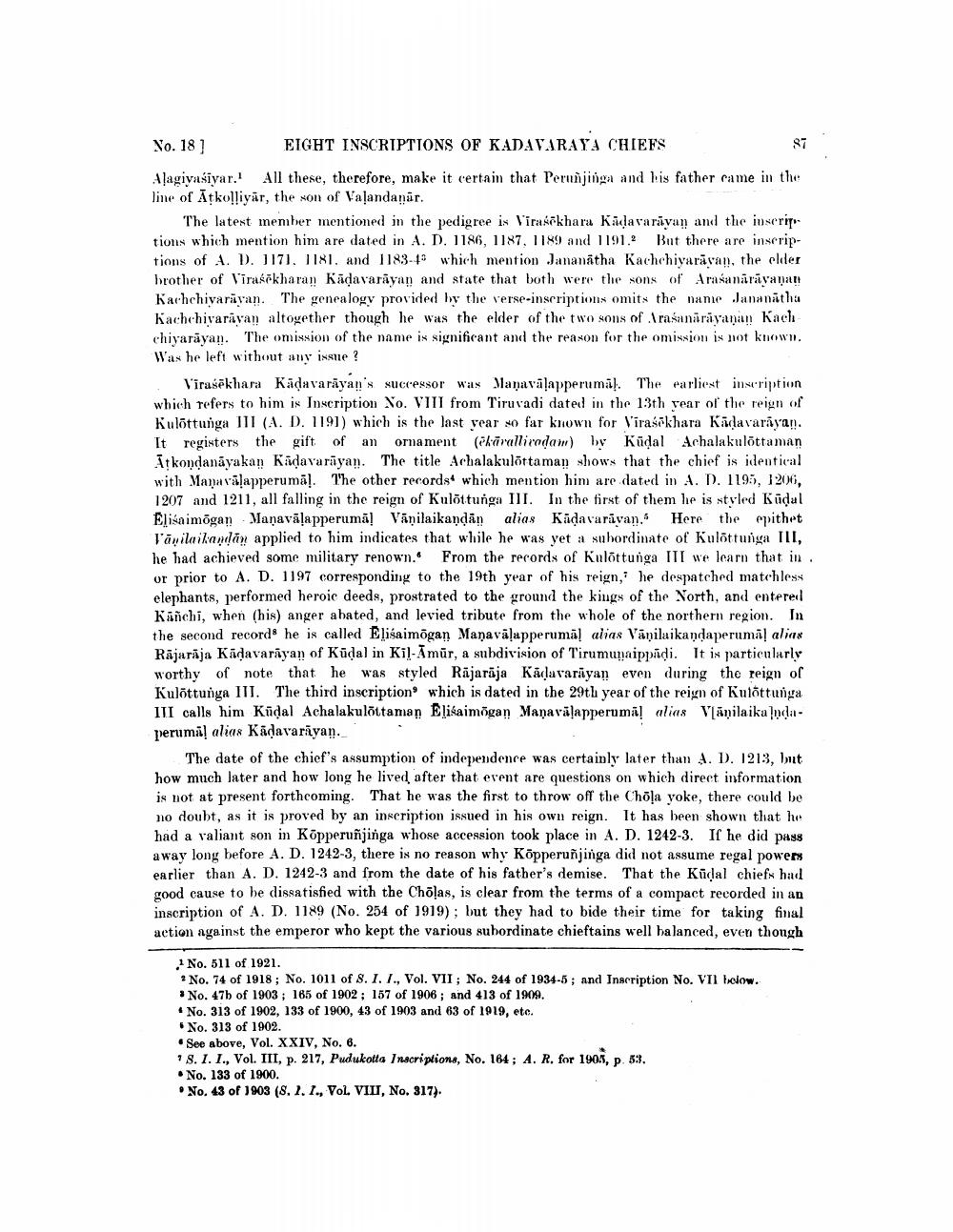________________
No. 181 EIGHT INSCRIPTIONS OF KADAVARAYA CHIEFS
87 Alagiyasiyar. All these, therefore, make it certain that Peruninga and his father came in the line of Ātkolliyār, the son of Valandanar.
The latest member mentioned in the pedigree is Virasēkhara Kadavaravan and the inscrip tions which mention him are dated in A. D. 1186, 1187. 1189 and 1191. But there are inscriptions of A. D. 1171. 1181. and 1183-18 which mention Jananátha Kachchivarāvan, the older brother of Virasokharan Kādavarāyan and state that both were the sons of Arašanārāvamalt Kachchivarāvan. The genealogy provided by the verse-inscriptions omits the name Jananatha kachchivaravan altogether though he was the elder of the two sons of Irašanārāyanan kach chiyarāyan. The omission of the name is significant and the reason for the omission is not known. Was he left without any issue?
Vīrasekhara Kādavarāyan's successor was Manavālapperumal. The earliest inscription which refers to him is Inscription No. Vill from Tiruvadi dated in the 13th rear of the reign of Kulõttunga III (A. D. 1191) which is the last year so far known for Virasekhara Kādavarayan. It registers the gift of an ornament (@kirallivadaw) by Küdal Achalakulóttaman Ātkondanayakan Kadavariyan. The title Achalakulóttaman shows that the chief is identical with Manavalapperumal. The other records which mention him are dated in A. D. 1195, 1200, 1207 and 1211, all falling in the reign of Kulõttunga III. In the first of them he is styled Kidal Elisaimõgan Maņavāļapperumā! Vānilaikandān alias Kādavaravan. Here the epithet Tāwilaikandān applied to him indicates that while he was yet a subordinate of Kulõttunga III, he had achieved some military renown. From the records of Kulõttunga III we learn that in . or prior to A. D. 1197 corresponding to the 19th year of his reign,' he despatched matchless elephants, performed heroic deeds, prostrated to the ground the kings of the North, and entered Kanchi, when (his) anger abated, and levied tribute from the whole of the northern region. In the second record he is called Elisaimõgan Manavālapperumäl alias Vänilaikandaperumal alias Rājarāja Kādavarāyan of Kūdal in Kil-Amūr, a subdivision of Tirumunaippādi. It is particularly worthy of note that he was styled Rājarāja Kadavarayan even during the reign of Kulõttunya III. The third inscription which is dated in the 29th year of the reign of Kutõttunga III calls him Kadal Achalakulóttaman Elisaimõgan Manavālapperuma alias V[änilaika ludaperumal alias Kādavarāyan.
The date of the chief's assumption of independence was certainly later than A. D. 1213, but how much later and how long he lived after that event are questions on which direct information is not at present forthcoming. That he was the first to throw off the Chola yoke, there could be no doubt, as it is proved by an inscription issued in his own reign. It has been shown that he had a valiant son in Kõpperuñjinga whose accession took place in A. D. 1242-3. If he did pass away long before A. D. 1242-3, there is no reason why Köpperuńjinga did not assume regal powers earlier than A. D. 1242-3 and from the date of his father's demise. That the Kūdal chiefs had good cause to be dissatisfied with the Chõļas, is clear from the terms of a compact recorded in an inscription of A. D. 1189 (No. 254 of 1919); but they had to bide their time for taking final action against the emperor who kept the various subordinate chieftains well balanced, even though
1 No. 511 of 1921. * No. 74 of 1918; No. 1011 of 8. 1. 1., Vol. VII ; No. 244 of 1934-5; and Inscription No. VIl blow. * No. 47 of 1903 ; 165 of 1902; 157 of 1906; and 413 of 1909. * No. 313 of 1902, 133 of 1900, 43 of 1903 and 63 of 1919, etc.
No. 313 of 1902. See above, Vol. XXIV, No. 6. * 8.1. 1., Vol. III, p. 217, Pudukotta Inscriptions, No. 164; A. R. for 1904, p. 53. .No. 133 of 1900. .No. 43 of 1903 (8.1.1., VOL VIII, No. 317).




